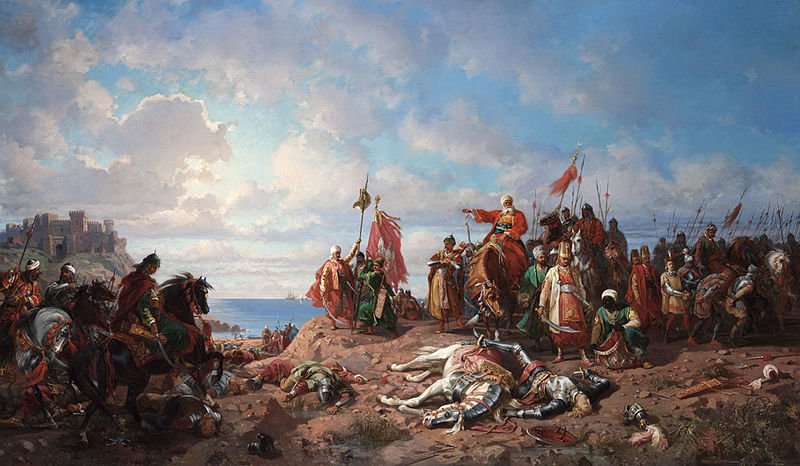King in Madeira!
“If you care to do a bit of digging on this island, it’s incredible what you might find!”
WLAD THE LAD
King of Poland, Władysław III, also known as Ladislaus of Varna was one of Europe’s most powerful rulers.
In the mid-1500s, Poland was the largest state in Europe and the continent's most powerful nation! Władysław III also known as 'Ladislaus' was its king and at the same time the Supreme Duke of Lithuania, King of Hungary and crown head of Croatia. In short, he was Europe’s most powerful figure.
MUSLIM ADVANCES
The Ottoman Empire (Turkey) was on the rise and the collective courts of Christian Europe were doing their level best to curb the Muslim advance. In November 1444, a combined Christian army of Hungary, Poland and Wallachia (a region of present-day Romania) led by King Ladislaus III went to war against the Muslim sultan, Murad II.
This did not go well! The Christians were roundly defeated at the ‘Crusade of Varna’ and sent packing! According to his adversaries, the Polish King fell in battle although, oddly enough, no body or royal armour was ever found!
MAD LAD
João Gonçalves Zarco, Madeira’s original discoverer looks over longingly to my apartment at Praia Formosa
Meanwhile, in the mid-Atlantic, the islands of Madeira had just been discovered. In 1419, driven off course by a storm, João Gonçalves Zarco and Tristão Vaz Teixeira landed on the island of Porto Santo and, grateful for safe haven they christened it the ‘Holy Harbour’ or Porto Santo.
They came back the following year on behalf of the Portuguese crown and claimed the entire archipelago. The colonisation of the two largest islands began almost immediately.
By September 23, 1433, the name ‘Ilha da Madeira’ first appeared on a map.
João Gonçalves Zarco was the discoverer and 1st Captain-major of Madeira.
MYSTERIOUS KNIGHT
Eleven years after the Battle of Varna and say 36 years after Madeira’s discovery, a mysterious knight appeared on the shores of Madeira going by the name of ‘Henrique Alemão’.
One of the two original discoverers of Madeira, João Gonçalves Zarco, was by then ‘Captain’ or governor of these islands and so impressed was he by this enigmatic ascetic, he afforded Henrique full hospitality and honours, humble though they might have been.
These events reached the ears of the Portuguese King Alfonso V who was equally moved to welcome the unassuming ascetic and bequeathed him significant lands in the area we now know as Madalena do Mar.
MADALENA DO MAR
The modern-day village of Madalena do Mar, located between Ponto do Sol and Jardim do Mar was only accessible by sea at that time.
Henrique took readily to his new habitat and soon established vineyards, vegetable gardens and sugar cane plantations as well as building a small church in the fertile little Faja!
The modern-day Church of Santa Maria in Madalena do Mar, coincidentally the same name of Columbus’s ship
“ He became known locally as ‘Henry the German’. ”
The pious pilgrim settled quickly and married Senhorinha Anes de Sá, the daughter of Infante (prince) D. Henrique, Duke of Viseu, one of the most prominent figures in the Portuguese court. And who was the best man at the wedding? None other than Alfonso V, the King of Portugal!!!
Excuse me! Just who was this Henrique guy?
THE PIOUS PILGRIM
“Could it be that ‘Henry the German’ was in fact King Władysław of Poland?”
King Władysław in action at the Battle of Varna, 1444 by Polish painter, Jan Alojzy Matejko (1838-1893) known for depicting important events from Polish history.
Could it be that ‘Henry the German’ was in fact King Władysław of Poland, one of the most powerful figures of 15th-century Europe? Had he survived the Battle of Varna and travelled in disguise to the Holy Land seeking penance for his deceptive tactics by breaking a 10-year truce with the Ottoman Turks?
The supposed death of King Wlad at the Battle of Varna as presented in a painting in the National Museum of Krakow
CARD UP HIS SLEEVE
Or was the ‘King of Poland’ here in Madeira, a man with a plan?
We can understand that such a public figure might have had enough of the pressures of Medieval Europe, the ongoing conflict with the Ottoman Empire and other general royal responsibilities. Maybe the guy had dropped out, retired and like so many of us chose Madeira to spend his days in peace and tranquillity, going along to Zona Velha for a Poncha or popping into Moynihan’s for the occasional pint of Guinness?
Or could it be there was a much more politically driven, premeditated reason for his appearance on this little-known but strategically positioned mid-Atlantic archipelago?
TRADE & PROFIT
Then as now, trade and profit were the primary motivators for most of Europe’s monarchs and their courts. The crown heads of every European country would go to any length to protect their fiscal interests - including war! The Ottomans had effectively cut Europe’s fiscal ribbon eastward the form of spices, silks, grains etc.
Le siège de Constantinople (1453) by Jean Le Tavernier
Doesn’t this sound familiar in a modern context?
THE AMERICAS
It is generally understood that the Portuguese and possibly the Spanish knew there was land across the wide Atlantic. Perhaps it was Japan or China. If so, they could reopen the trade routes to the Far East, effectively circumnavigating the Ottoman’s stranglehold on Constantinople.
I believe they had pretty good ‘intel’ that, if it wasn’t a route to the ‘East Indies’ there was a whole new continent waiting to be discovered, explored and exploited… the Americas!
BIGGER FISH
So, once again, why would such an important European crown head end up living in Madeira?
I think our ‘Henry’ had much bigger fish to fry in the form of establishing a) possible new trade routes to the Orient and b) discovering two entirely new continents.
I posture that Ladislaus was in cahoots with the King of Portugal, (the best man at his wedding for God's Sake).
I believe these two European kings had got their collective crown heads together and contrived an intricate plan to send an expedition west and at least have some ‘skin in the game’ with their old adversary, Spain!
SPANISH CASTLES
The marriage between Isabella I of Castile and Ferdinand II of Aragon united a once-heavily-diversified Spain simultaneously making it the first truly global superpower. And Portugal, realising it was no longer the top ‘discoveries’ dog wanted in on the action!
And who was given the responsibility to keep Portugal in the game? Was it Cristiano Ronaldo? No, it was Henry the German’s son, Prince Segismundo aka ‘Christopher Columbus’.
In typical international espionage style, the two kings made out that Segismundo had been downed on a trip to Lisbon. Lo and behold, not long after, Christopher Columbus appeared, firstly in Lisbon, living there for nearly 8 years before he went knocking at the palace door in Seville. The rest is… as they say ‘his story’!
Meeting of S. Joaquim and Santa Ana next to Porta Dourada , a painting that was on the altar of the primitive oratory built by Henrique Alemão, and which is supposed to represent himself with his wife, Senhora Anes, according to the usage of the time.









